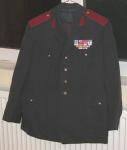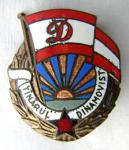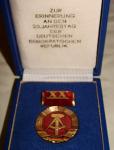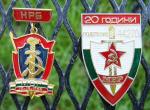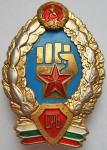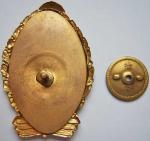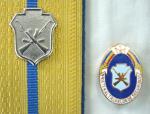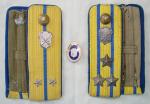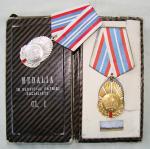-
Posts
1,742 -
Joined
-
Last visited
-
Days Won
3
Content Type
Profiles
Forums
Blogs
Gallery
Events
Store
Everything posted by Greg Collins
-
Romania The Romanian Securitate
Greg Collins replied to Greg Collins's topic in Central & Eastern European States
Picked up a couple Ministry of Internal Affairs badges... the badge on the right, an un-numbered pin back, is for an amateur artistic competition (probably music) and, based on the overall look of the badge, I would say from the RSR period. The badge on the left is for Culural Work and is of the stick-pin type. It looks to be 3-piece construction (the torch, the circular band bearing the type, and the base), and is numbered on the back- 1147. I believe it is of the RPR period. Both bear the "MAI" legend. -
Romania The Romanian Securitate
Greg Collins replied to Greg Collins's topic in Central & Eastern European States
Now to the ribbon bar, which is impressive. I won't bother to name all the awards as we all know most (if not all) of them already. The one foreign award is at the last place- the "30 Years of the Bulgarian Peoples' Army" commemorative medal. The awards I'm concerned with are the Orders of Military Merit (in places 1,2 and 5), the Medals of Military Merit ( in places 11 and 12), the Order for Distinguished Services in Defense of the Social Order and the Country - 3rd Class (in place 4) and the Defense of the Country medal (in place 13). From these ribbons, would it be correct to deduct that this individual was: - very possibly a Colonel or General (over 25 years of service showing), and may have been in the regular Army (unless Military Merit orders and medals were given to the Ministry of Internal Affairs personnel). - and a member of the Securitate (award #4). Also, what organizations were awarded the Defense of the Country (De straj? Patriei) medal? Thanks for the help! -
Romania The Romanian Securitate
Greg Collins replied to Greg Collins's topic in Central & Eastern European States
I don't own this item, but it was offered to me recently. As I don't collect uniforms because, frankly, I just don't have the room to do so, I turned it down. I did, however, make an offer for the ribbon bar- we'll see how that goes. Anyway, it was offered as a Militia uniform. Appears to be either charcoal gray or navy; dark red stripe on the pants and dark red piping on the cuffs; same colour collar tabs; dark red epaulets trimmed in blue. I'll get to the ribbons on the next post. I did have to lighten the image to show detail. -
Romania The Romanian Securitate
Greg Collins replied to Greg Collins's topic in Central & Eastern European States
Another problem when collecting Romanian items- and this is true of all Romanian items from 1947-1989- is that there is pitifully little reference available. I recently acquired Rainier Schmitt's book and, while it's a pretty good reference on what's available in orders and medals, it does not get to the depth that, say, Ralph Pickard's "Stasi Memorabilia" or McDaniel and Schmitt's book "Comprehensive Guide to Soviet Orders and Medals" does. Both give a good foundation in discovering fakes in their respective catagories. Also, the lack of a numbering system, the lack of mint marks, and the apparent lack of standardization doesn't help, either. Common sense and comparison against a known "standard" may be the rule of the day at this point. Though frustrating at times, I will say that this particular pursuit continues to be quite motivating and I am thorougly enjoying it. -
Romania The Romanian Securitate
Greg Collins replied to Greg Collins's topic in Central & Eastern European States
Thanks for the detailed reply; all the information I can get really helps in this pursuit. I think what this all boils down to, as a collector, is avoiding the "hype" that surrounds the term "Securitate" and realize the misuse of the term, either intentionally or not, by some dealers to enhance the saleability of their product, which may simply be associated with the normal police or security troops. I certainly understand and agree, and have seen it happen certainly with DDR items where so much is advertised as "Stasi" that absolutely is not. In the meantime, I'll continue the quest for written and web materials on the subject to try to gain a better understanding and, of course, use the information gained to enhance the collection. -
Romania The Romanian Securitate
Greg Collins replied to Greg Collins's topic in Central & Eastern European States
Wasn't the Securitate part of the ministry of internal affairs from 1972 when the council of state security and the so-called "ministerul afacerilor interne" were joined under the name "ministerul de interne"? I realize this would be after the production of this particular pin. The opportunity for recruitment was a supposition on my part as just about every country I know of engages in that sort of thing. We certainly do here in the US. This is a problem that I am encountering often in this facet of my collecting- maybe even more so than with my DDR MfS collection. What is Securitate? What is Militia? What is Security Troops? Do they overlap? When? And, in the few instances where there is written material available, the data only enforces these questions. The only answer I can really come up with is that there was a "fluid" overlap between State Security and Internal Affairs during the entire course of the Romanian Communist State, and to really say you're collecting the Securitate, you have to collect both. That is, until better data- if it exists- presents itself. This is my approach, anyway. -
Romania The Romanian Securitate
Greg Collins replied to Greg Collins's topic in Central & Eastern European States
I have been told that, like the KGB (USSR) and the MfS (DDR), the Dinamo was the athletic club of the Securitate/Ministry of the Interior. I've also been told that a certain amount was deducted from police paychecks for the Dinamo football clubs in both Bucharest and Victoria. Here's an older (I'd say '50's or '60's), nice looking and well made badge of a "Young Dinamo-ist".I would imagine this (youth athletics) was a useful tool in spotting and cultivating potential future agents. The badge is un-numbered and with a standard pin back. -
Romania Romanian Ribbon Bars
Greg Collins replied to Greg Collins's topic in Central & Eastern European States
Kevin: you're absolutely right about the Order of Military Merit, 3rd Class and I have edited the post... "cut and paste" combined with an early hour and not enough coffee is disastrous! Do the first two bars belong to the same person? Who really knows. Compared to other Warsaw Pact countries, Romania had relatively few awards. So to see several individuals with the same ribbon bar would be a fairly common occurrence. Could it belong to a female? Why not? Communism really does not allow for discrimination between sexes, and we've all heard of the exploits of Soviet women in their military. I would suppose Romania would do likewise, but to be sure, I guess we'll have to hear from someone who was there as there are damn few books available on the subject. The even number of rows is a very plausible point. Makes sense. I believe all the bars here represent a fairly high ranking officer based on the common award in all three- the Order of Military Merit, 2nd Class- which represents 20 years of service. I would say, at least, Major. A last note; there are no, per se, "hero" awards here. Some could have been awarded for heroism, but without documentation we can only speculate. The only thing we can easily assume is that we're looking at superior service awards. -
Romania Romanian Ribbon Bars
Greg Collins replied to Greg Collins's topic in Central & Eastern European States
And last, for now, from the RSR (1965-1989) period. Back to four across. This bar is also military; I keep saying this because ribbon bars were also worn by civilian party members, and I will show some of these in the future. You'll notice here that, instead of soldered rows there is a "full closure" back- much more stable. You'll also notice that the rendering of the ribbons is not as nicely done as in the RPR period- shaky lines. The awards are: Order of Military Merit, 2nd Class (20 Years) Order of Military Merit, 3rd Class (15 Years) Order of Tudor Vladimirescu, 4th Class Star of Romania, 5th Class 50th Anniversary of the Communist Party 20th Anniversary of the Liberation of the Country 25th Anniversary of the Liberation of the Country 30th Anniversary of the Liberation of the Country from Fascist Domination Medal for Military Merit, Gold (10 Years) Medal for Military Merit, Silver (5 Years) 25th Anniversary of the Proclamation of the Republic 20th Anniversary of the Armed Forces 30th Anniversary of the Armed Forces -
Romania Romanian Ribbon Bars
Greg Collins replied to Greg Collins's topic in Central & Eastern European States
Next up, another military bar from the same (RPR) period. The odd thing about this one is the rows of three, as opposed to four which is much more common. One possible reason could be that this ribbon bar was for a female or, perhaps a man of slight build. Without documentation it will remain a mystery. Anyway, the awards shown are: Star of Romania, 5th Class Order of Military Merit, 2nd Class (20 Years) Order of Labour, 3rd Class Order of Military Merit, 3rd Class (15 Years) Liberation from the Fascist Yoke Medal for Military Merit, Gold (10 Years) 10 Year Anniversary of the Foundation of the Army 20th Anniversary of the Armed Forces 20th Anniversary of the Liberation of the Country -
I have a few Romanian ribbon bars, both from the RPR and RSR periods, that I thought I'd share. First off, a decidedly military bar from the RPR (1947-1965) period with the following awards (left to right, top to bottom): Star of Romania, 5th Class Order of Military Merit, 2nd Class (20 Years) Order of Labour, 3rd Class Order of Military Merit, 3rd Class (15 Years) Liberation from the Fascist Yoke Medal for Military Merit, Gold (10 Years) 10 Year Anniversary of the Foundation of the Army 20th Anniversary of the Armed Forces
-
Thought I'd add my 2 cents here. Got in touch directly with Frank Bartel on this award and, although he indicated very little is known about particulars of the award, it should be classified, as has been pointed out, as an SED Honour Award. I'm fortunate enough to have one in it's original case (no document though). As the medal's obverse has already been shown, I'm including images of the medal in case and the reverse of the medal.
-
Bulgaria Bulgarian Ministry of Interior Awards
Greg Collins replied to Stogieman's topic in Central & Eastern European States
Thanks! Still looking for one like you have in post #84, though. -
Bulgaria Bulgarian Ministry of Interior Awards
Greg Collins replied to Stogieman's topic in Central & Eastern European States
My final submission (for now) is a group of 3 variations of the MVR Excellence badge. As the top badge (bronze with hot enamel; screw back) and the lower right badge (enamel over light alloy; pin back) have already been discussed, I'll move to the badge on the left. It is, essentially, the same as the top badge in that it is bronze and screw backed. Where it differs is in the use of what I believe to be baking enamel. One of the characteristics of baking enamel is that a decided colour shift occurs once the piece is baked. In other words, the colour that is applied will change during the baking process. Also, the colours are dull- nearly flat- and deffinitely not shiney and lusterous as with hot enamel. I believe this badge dates to the mid to later '70's. -
Bulgaria Bulgarian Ministry of Interior Awards
Greg Collins replied to Stogieman's topic in Central & Eastern European States
A couple of commemorative badges made of light alloy with pin backs. The badge to the left, which appears to have hot enamel and mimics the design of the '65-'80 Honour Badge is one of very few badges not listed in Dr. Riemer's book and the only thing I know about this badge was that it was given to other Warsaw Pact contemporaries (Ralph Pickard informs me that he has one that was given to a member of the Stasi). The badge to the right is commemorative of 20 years of a specific police unit (44270) that, apparently, was mobilized to quelle riots in the '80's (this info was given to me only in conversation). -
Bulgaria Bulgarian Ministry of Interior Awards
Greg Collins replied to Stogieman's topic in Central & Eastern European States
Thought I'd add a few that have not been shown already. First up is an '80's Police Riot Control badge... fairly rare piece covered in Dr. Riemer's book. As can be seen, there is a hand-to-hand (martial arts) connotation to the badge, and the design recalls badges that were produced in the 1940's. -
Space Rangers Mutant Cosmic Radioactive Scarab Beetle or
Greg Collins replied to a topic in South East & East Asia
The particular version of the badge shown is actually post-1965... the seal is for the Romanian Socialist Republic. The earlier version will have the red star with RPR on a blue circle (Romanian Peoples' Republic). The damn things look like dragonflys to me. -
Soviet Soviet Badges MVD / OMOH
Greg Collins replied to KDVR's topic in Russia: Soviet: Other Militaria
Interesting gathering... the first badge is not Soviet but, rather, recent Russian Federation Police. I would venture a guess a say it's official if for no other reason than the screw back- but I really don't know. The second badge is interesting; looks to be fairly old. Not official in the Soviet sense as it does not have Moneteny Dvor on the back nor on the tightening wheel but does have a locally produced feel to it. The Islamic minaret next to the Atheist Soviet seal is absolutely weird. Probably a commemorative badge of some kind made locally to the event. The last badge has Kommsomol overtones. The relative sloppiness in the paint would indicate this is not an official badge but, maybe, a badge produced privately by a particular class. Ther were many such badges made. -
Romania The Romanian Securitate
Greg Collins replied to Greg Collins's topic in Central & Eastern European States
Thanks for all the replies... it seems that, without a list of Securitate personnel, it would even be hard to match up a brevet... and I sure have not seen a list (if one survived 1989). I guess the best we can do is say this award was for the protection of the social order and the state and could have been for a member of the Securitate. Or simply say this award was for a member of internal security (militia, security) and leave it at that. I have a question at this point... do any of you know of a book or website that would show Romanian uniforms of 1947-1989? I'm familiar with the world insignia website, but have no reference to uniforms whatsoever. I'd certainly appreciate any help in this area. -
Romania The Romanian Securitate
Greg Collins replied to Greg Collins's topic in Central & Eastern European States
The very few images I have seen of the Securitate show individuals in street clothing, more or less the same as our FBI or CIA (or any of a long list of "alphabet soup" agencies we have here in the US), so I quite understand what you're telling me. It seems the Securitate operated similarly to the Stasi when it came to the uniformed services... used who they needed but kept them in the uniform they already had. Of course, the Stasi (MfS) had the Watch Regiment, but that was largely cerrimonial. Would you say that I would be more accurate in describing my collection as "Security and Militia" rather than "Securitate"? -
Romania The Romanian Securitate
Greg Collins replied to Greg Collins's topic in Central & Eastern European States
Actually, I just found out that the direct translation of the badge is "Friend of Security Troops"... no mention of "youth" or "young" as I was led to believe. So, with that in mind, could this be a badge to indicate a monetary donation or, possibly, some sort of auxiliary? -
Romania The Romanian Securitate
Greg Collins replied to Greg Collins's topic in Central & Eastern European States
One of the issues I'm facing in the pursuit of Securitate items is the length and breadth of the organization- more or less similar to what I faced in collecting the DDR Stasi. Many in uniform were part of the more visible community- military units, police- but so many never wore, or at least rarely wore, a uniform in the commission of their day to day duties. As I collect that which is more visible (orders, medals, badges and small insignia- I don't do uniforms as I would need another house), I'm more or less stuck with the units that did display these items (security and militia). Here's a close up of the badge along with the same insignia on one of the shoulderboards. -
Romania The Romanian Securitate
Greg Collins replied to Greg Collins's topic in Central & Eastern European States
A final post for now... a couple pairs of epaulets, one colonel and the other lieutenant, flanking a Young Trooper of the Securitate badge. -
Romania The Romanian Securitate
Greg Collins replied to Greg Collins's topic in Central & Eastern European States
A couple of Medals for Service to Socialist Country (Medalia "?n serviciul patriei socialiste"). The gold (1st Class) is the RPR version and was awarded between 1963-1965. The silver (2nd Class) ia the RSR version and was awarded between 1965-1989. The delapidated case that has , unfortunately, come in two parts is for the gold medal. -
Romania The Romanian Securitate
Greg Collins replied to Greg Collins's topic in Central & Eastern European States





